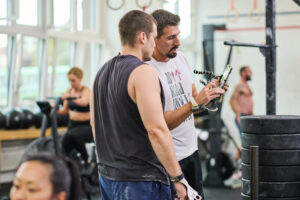
Fitness programming only works when it’s followed the way it was designed. This is one of the most misunderstood concepts in training — especially today, when you can buy programs online, mix and match workouts from different platforms, or pick classes based on what looks fun that day. But here is the truth that matters for anyone who wants real, long-term progress:
You’re either following a program, or you’re not. There is nothing in between.
This isn’t about perfectionism or judgment. It’s about clarity — and understanding how progress actually happens.
What a program really is (and what it isn’t)
A program is not a list of workouts.
A program is a structure that builds your fitness layer by layer:
- Strength → skill → power → conditioning
- Planned recovery and deloads
- Specific rotations of movement patterns
- Energy system variations
- Progressions that repeat and evolve
- Testing weeks that measure results
When you follow the structure, the program works as intended.
When you change the structure, you’re no longer on the program — you’re on your own version of it.
And that is perfectly fine. But it’s important to call it what it is.
Why cherry-picking isn’t following a program
A very common pattern is cherry-picking — choosing workouts based on what looks enjoyable, comfortable, or familiar. People often do this without even noticing.
But here’s the key insight:
Cherry-picking does not create variety. It reduces it.
When you skip running days, heavy days, gymnastics days, or workouts that push a weakness, your training narrows. You repeatedly train the same strengths and repeatedly avoid the same gaps. Over time, this is the opposite of what real fitness needs.
Avoiding a workout because it contains something you dislike (“I’m not coming, there’s running”) is not goal-oriented training — it’s simply avoiding discomfort.
The irony?
The days you like the least are usually the days you need the most.
Fitness programming for real people: 3-day vs. 5-day training
Whether you train three days a week or five days a week, the principle stays the same:
Show up on the days you can, and trust that the program is doing the balancing for you.
At CrossFit Kreis 9, our fitness programming rotates strength, conditioning, skills, intensity, power, and aerobic/anaerobic work across the entire week. You don’t need to choose the “correct” days. The structure ensures that over time, you get exposed to everything you need.
Skipping based on preference interrupts that balance.
Showing up consistently — even on “random” days — supports it.
When reducing variety is the right move
Sometimes narrowing your training is intentional. Examples:
- Building strength in a specific lift
- Training for a race
- Developing a gymnastics skill
- Preparing for a competition
- Addressing a specific imbalance
- Working on body composition goals
In these cases, reducing variety is purposeful — and planned.
But this requires structure, progression, recovery management, and thoughtful supplementation. Not “doing extra” randomly and not avoiding classes based on dislike.
This is where coaching matters.
Talk to your coach if you have a specific goal
If you’re training for something specific, the solution is simple:
Together, you can:
- Adjust the fitness programming for your goal
- Add accessory work that supports — not conflicts with — the program
- Ensure recovery is built in
- Avoid overuse and burnout
- Keep your base fitness improving while targeting specifics
Goal-oriented training needs intention, not impulse.
This is one of the biggest benefits of training at CrossFit Kreis 9:
You always have access to professional, full-time coaches who can guide you.
Why following a program matters
When you follow a program as written, you get:
- Better progressive overload
- Improved strength and skill development
- Balanced energy-system training
- Reduced injury risk
- Predictable progress
- Accurate testing results
- Long-term fitness that supports real life
These benefits are the entire purpose of fitness programming — and they only appear when the structure is followed. This doesn’t mean you need to train every day. It means that whatever days you do train, you trust the system.
How we build training at CrossFit Kreis 9
Our programming is designed for busy professionals with limited time who want maximum return on every session. It includes:
- Strength cycles
- Rotating conditioning intensities
- Periodized skill focus
- Power development
- Movement pattern balance
- Testing phases
- Long-term planning
- Adjustments for age, lifestyle, and goals
You don’t need to worry about choosing “the right workouts.”
That is what our coaches and programming take care of.
Your job is simply to show up consistently and train with intention.
In summary
There are two fully valid ways to train:
1. Follow the program
→ Structure
→ Balance
→ Measurable progress
→ Predictable results
2. Train for enjoyment
→ Flexibility
→ Autonomy
→ Mood-based decisions
→ Activity for its own sake
Both are good.
Both are healthy.
Both fit different seasons of life.
Just be clear which one you’re doing — so your expectations match your approach.
And if you want your training to support long-term, measurable change, a well-designed program followed consistently will always outperform cherry-picked workouts or intuition-based training.
At CrossFit Kreis 9, we’re here to help you make the most of whichever path you choose.




